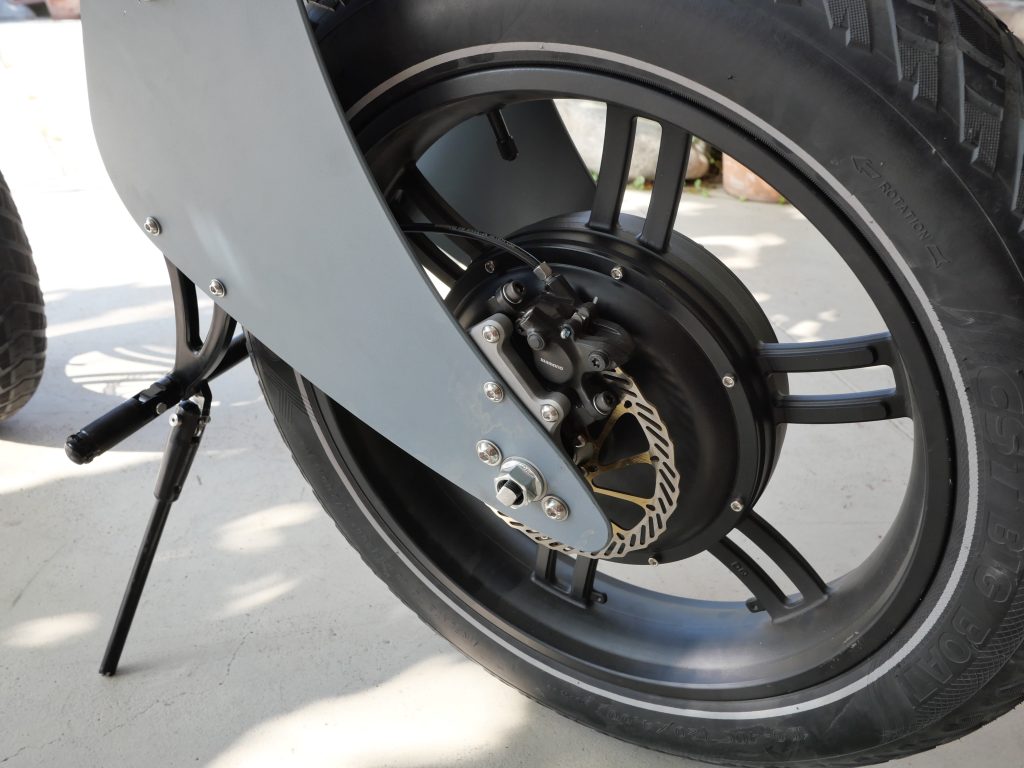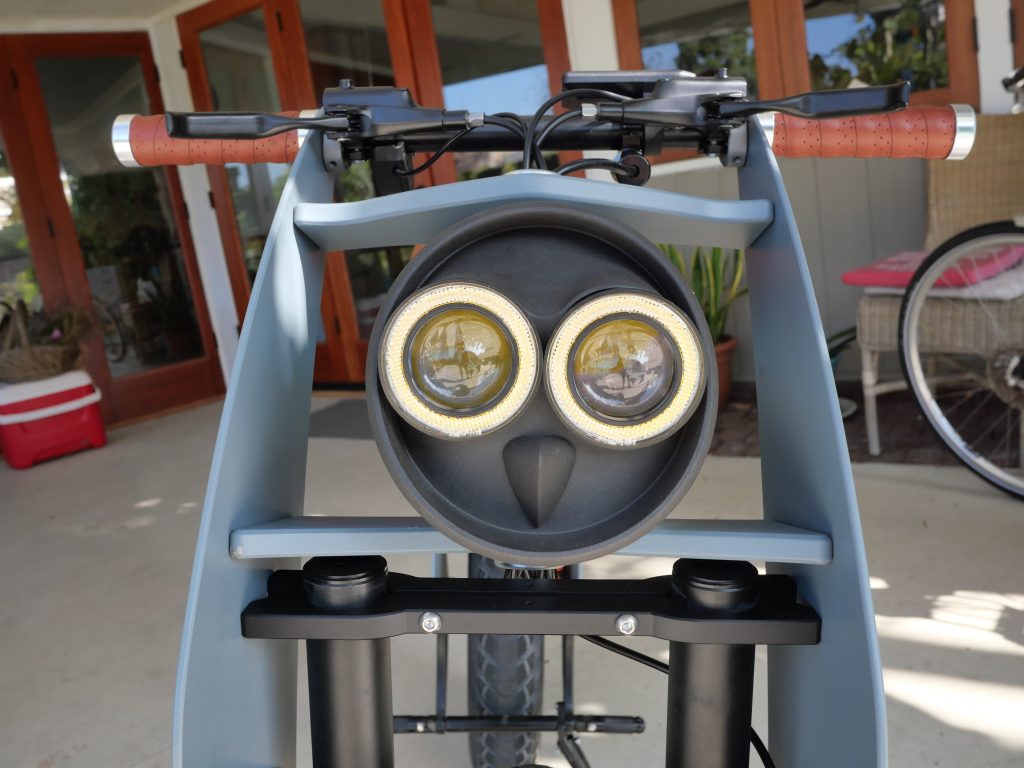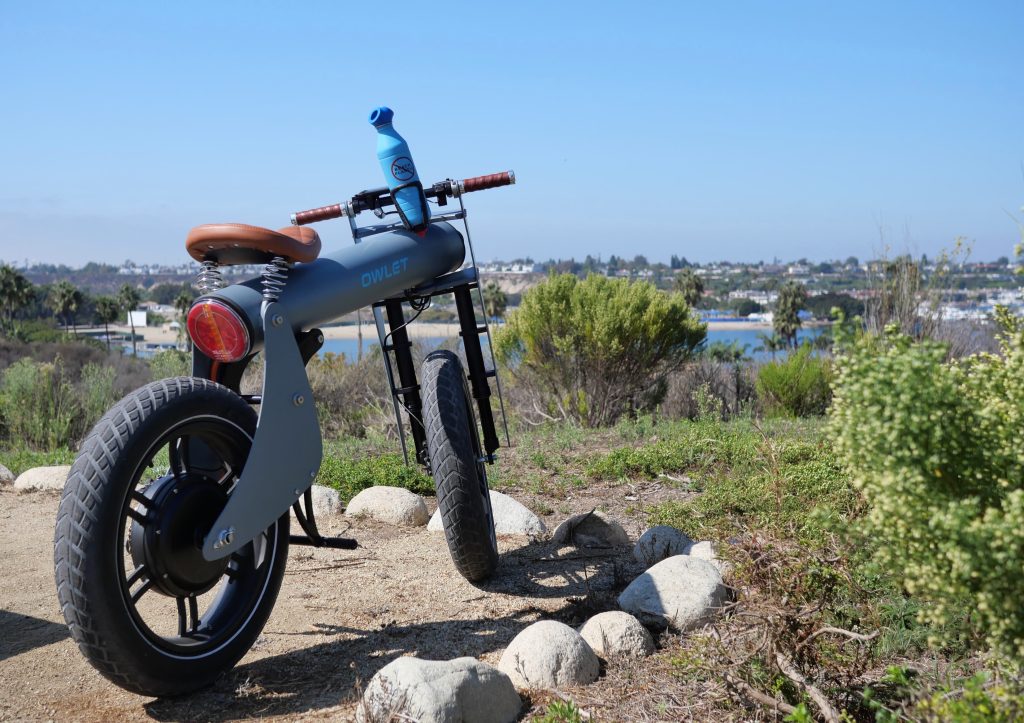We got to ride a pre-production model of a striking new e-bike/e-moped, the Owlet One, with lots of power in a small package.
We first met Owlet at Electrify Expo in Long Beach, CA, where we only had a couple minutes on its bike. But since the company is headquartered nearby in Los Angeles, they emailed us asking if we’d like a longer test ride, and delivered a bike to us for to spend a few hours on this time.
Just to set the stage for this ride: Owlet is a new brand, preparing to ship its first bike. So to start off, we rode a prototype, not the finished version. This means it may come with different features, and we’re not entirely sure when it will ship, either.
The first thing to notice about the Owlet One is its design, which certainly stands out immediately. The bike is made of aviation-grade aluminum, though is still quite hefty, tipping the scales at 84 lbs (but it felt even heavier in our hands).



On top of Owlet’s striking design, the bike is also somewhat of a unique shape and size. Despite offering a format that looks similar to an e-bike at first glance, it rides more like a small moped. This actually puts its 84lb weight into a different perspective – rather than being heavy for a bike, it can be thought of as light for a moped.
But photographs can’t encapsulate everything about the design of the Owlet, because it has one totally unique feature: an adjustable wheelbase.
This can be done by one person in under a minute, though requires a socket wrench and a small amount of elbow grease.
In practice, I found that the adjustable wheelbase probably won’t come up much for riding purposes. The longest wheelbase (or close to it) was the most comfortable and stable to me, and shorter wheelbases were a bit more of a novelty, especially on this powerful bike which can get a little squirrelly on the shorter settings.
Another issue is that it changes the angle of the kickstand, which means you can’t really use the kickstand outside of a narrow wheelbase range. The final bike will supposedly have a different kickstand design, but this will likely be an issue regardless of how it’s redesigned.
But it was good for making the bike small enough to fit into places you might not normally be able to fit a moped-style bike. Between its narrow handlebars and shrunk down to its smallest 44-inch-long setting, it fit into the back of both a Tesla Model Y and an Audi A3 wagon (both with seats down), but not quite into a Model 3 – which I’ve fit multiple normal-sized bikes into the back of, though with the front wheel removed. Though its hefty weight does mean it can be awkward to lift the bike in there in the first place.



And it’s got more power than you’d expect out of most e-bikes too. With a 750W motor (3000W peak), there’s plenty of get up and go, and plenty to keep you going even as you reach closer to its 30mph top speed. This top speed can be lowered through the bike’s computer, to fit your local regulations.
Speaking of regulations, the bike is officially categorized as a motorized scooter, rather than an actual e-bike, as it doesn’t have pedals. It’s in a similar category to electric kick scooters, so you need to have any class of driver’s license to ride it, though it can be used either on or off public roads (but check your area’s regulations for sidewalk use, helmet requirements, and so on).

The throttle we tested was a thumb throttle, though we would have preferred a twist throttle. The thumb throttle is just too twitchy, and on a bike with such peaky acceleration, it could get jumpy. This was especially true with shorter wheelbase settings. Owlet says there will be an option for a twist throttle when the bike ships, but we’d also like to see the software moderate acceleration on the very low end even with the thumb throttle.
And the bike is fully throttle-driven – there are no pedals, only pegs. Owlet plans to offer an option for pegs attached to the front to allow a different, more laid-back seating position.

I tested the bike with a few accessories I had laying around, but because of the Owlet’s unique design, not all of them would fit (the handlebar cupholder seen in some of my photos doesn’t come with the bike, for example, which has no bottle cage mount). You’ll probably want a backpack if you’re planning to carry things on this bike, rather than saddlebags or the like.

Owlet says the bike’s 1500Wh battery (made with 2170-format cells) can take you around 40-60 miles, and comes with a 350W charger for a ~5 hour charge. Based on our test ride, we think this range is reasonable or perhaps even conservative – but I’m also a pretty lightweight rider at 155lbs, and always remember that e-bike ranges vary widely depending on terrain and rider.
The seat has a very cool look to it and is comfortable to sit on, partially due to integrated seat suspension. The front fork also has 3.5 inches of suspension travel. I’d have liked for both suspensions to be a little looser, but that is again likely due to my relatively light weight.

All of this comes with a caveat: we rode a prototype here, not a final bike. So the bike was missing some final features, some features weren’t working (like the headlight), and so on. Owlet says that specifically the LCD and foot stands will be changed, but we imagine other tweaks are possible (we hope one of the LCD changes makes it easier to read with polarized sunglasses – it was a bit tough, which is true of many, but not all, bike computer screens).

Owlet also has plans for a future bike, the Owlet 2, which is more solidly in the moped category, with a less wild design and higher range and top speed. Owlet shared an early prototype fact sheet with us, but given the One is already a bit of a ways out from delivery, don’t hold your breath for the 2 yet.

In short, the Owlet is a fun, quirky ride with a very design-forward ethos. If you’re looking for a bike that doesn’t look like any other, it could be worth looking into. Though it’s definitely on the unorthodox side and you have to be willing to accept its eccentricities when compared to more conventional two-wheeled devices.
The company is taking $50 refundable deposits for its bike, which it has said it wants to ship around March – but it also says that it’s waiting for a minimum batch quantity of preorders first, and that shipments would take 3-6 months after that, so we imagine March could be optimistic. If you want to get in line, you can reserve one here.
The bike will cost $3,995, though early reservers can get it for $2,995, along with an engraved serial number and a 1 year warranty/service package. Owlet wants to have service locations around LA and possibly one in New York, to begin with. It will distribute the bikes by shipping them directly to customers.
If you’re an e-bike/motorcycle/scooter owner, charge them up at home with rooftop solar panels. To make sure you find a trusted, reliable solar installer near you that offers competitive pricing on solar, check out EnergySage, a free service that makes it easy for you to go solar. They have hundreds of pre-vetted solar installers competing for your business, ensuring you get high-quality solutions and save 20-30% compared to going it alone. Plus, it’s free to use and you won’t get sales calls until you select an installer and share your phone number with them.
Your personalized solar quotes are easy to compare online and you’ll get access to unbiased Energy Advisers to help you every step of the way. Get started here. – ad*


